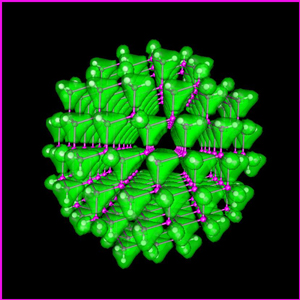A new development from the University of Alberta in Canada brings quantum dot-based devices within reach. Existing quantum dots, sometimes referred to as "artificial atoms", have a typical diameter of 10-2 nanometers and are expected to have many applications

Single-atom quantum dots prepared by researchers from the Canadian National Institute of Nanotechnology and the University of Alberta enable a new level of control over individual electrons - a development that brings quantum dot-based devices closer to reach.
The dots, which consist of a single atom of silicon (silicon) and are only one nanometer in diameter, are the smallest quantum dots ever prepared.
A quantum dot According to Wikipedia, (Quantum dot) is a nanometer semiconductor compound conduction band of high value electrons or excitons. Because they are so-called zero-dimensional, quantum dots have a greater separation between the energy levels and the possibility of controlling the position of the levels. As a result, they are more efficient in conduction and optics, and are being researched for application in diodes for lasers, amplifiers, biological sensors and in converting solar energy to electricity instead of the silicon we use today.
Quantum dots have unusual electronic properties, such as the ability to confine fast and elusive electrons. This control over the interactions between electrons can be used in various fields of calculation. Until now, the use of quantum dots was only possible at very low and impractical temperatures, but the new quantum dots with the size of only a single atom also function at room temperature.
Existing quantum dots, sometimes referred to as "artificial atoms", have a typical diameter of 10-2 nanometers. Although they consist of several thousand atoms, all the atoms attract the electrons cooperatively, so that they coordinate with each other as if there was a single atomic nucleus in the center. This feature provides several revolutionary programs for electronic devices.
The head of the research project, Robert A. Wolkow, describes the possible impact by saying: "Since they operate at room temperature and exist in the silicon crystals used in computers today, we expect that these single-atom quantum dots will replace theoretical programs with practical devices." Quantum dots from a single atom provide another advantage - significant control over individual electrons using little energy. The lead researcher sees this low-energy control as the key application of these quantum dots in entirely new types of semiconductor-based electronic devices, such as ultra-low-energy computers.
"The ability to produce such quantum dots on Zorn, the most basic material in the field of electronics, and gaining control over the position of a particular electron between these dots at room temperature, are bringing completely new types of computing devices that consume little energy within reach."

3 תגובות
In the name of honesty and fairness, I would expect the writer to ask me for permission before writing a personal article about my relatives.
Ah.. Obviously you didn't understand because you didn't take the interesting course in one of the electrical engineering faculties - solid state devices.
And seriously - when the wavelength is very close to the physical dimensions of the device, as in this case, you can get lighting and calculations on a nanometer basis and the type of material loses its importance - that is, it doesn't matter if it has a direct or indirect gap, what matters is that in terms of its structure, it has a spectrum of a single atom.
I did not understand why it is called a single atom when it is a multi-atomic structure.
And what is the difference from a metallic "electron sea".